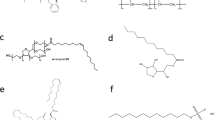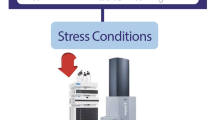Abstract
Examples of the use of subambient DSC for characterizing excipients which have the melting range within ambient or subambient temperatures as well as liquid and semiliquid dosage forms are presented in the following paper.
Influences of the quality, polymorphism, storage of excipients used for dosage forms and changes in the composition on the melting behaviour and quality of dosage forms were investigated.
Changes of the melting behaviour of dosage forms determined with subambient DSC have shown to correlate with the quality of the dosage form, the quality of excipients used or structural changes (due to various influences) in the dosage form. DSC for use in the range of subambient and ambient temperatures represents an alternative analytical method for development and quality assurance in pharmaceutical industry for liquid and semiliquid preparations.
Similar content being viewed by others
References
K. Klokkers, Acta Pharm. Technol., 31 (1985) 151.
K. Klokkers, Acta Pharm. Technol., 30 (1984) 10.
H. Junginger, Pharm. Weekblad Sci. Ed., V6 (1984) 141.
G. Eccleston, Drug Develop. Ind. Pharm., 14 (1988) 2499.
G. Eccleston, Int. J. Pharm., 27 (1985) 311.
P. Mura et al., Int. J. Pharm., 119 (1995) 71.
L. Potier, Thermochim. Acta, 204 (1992) 145.
U. Lashmar et al., Int. J. Pharm., 125 (1995) 315.
R. Gordon et al., Int. J. Pharm., 21 (1984) 99.
G. Indrayanto et al., Drug Develop. Ind. Pharm., 20 (1994) 911.
C Z. Chowhan, Pharm. Technol., Eur. November, (1993) 33.
L. Cohen, Pharm. Technol., Eur. January, (1994) 14.
M. Gray et al., JAOCS, 55 (1978) 601.
I. Norton et al., JAOCS, 62 (1985) 1237.
D. Kodali et al., JAOCS, 61 (1984) 1078.
L. Hernqvist, Fat Sci. Technol., 90 (1988) 451.
D. Kodali et al., J. Lipid Research, 31 (1990) 1853.
T. Arishima, JOACS, 66 (1989) 1614.
D. Dorset et al., Chem. Phys. Lipids, 48 (1988) 19.
D. Giron, Thermochim. Acta, 248 (1995) 1.
J. Sarciaux et. al., Int. J. Pharm., 120 (1995) 127.
Ch. Müller-Goymann, Pharm. Research, (1984) 154.
G. Eccleston, J. Soc. Chem., 41 (1990) 1.
H. Tiemessen, Progr. Colloid Polymer Sci., 77 (1988) 131.
H. Junginger, Topics in Pharm. Sci., (1985) 329.
G. Eccleston, Pharm. Int. March, (1986) 63.
Ch. Müller-Goymann, Acta Pharm. Technol., 35 (1989) 116.
Ch. Müller-Goymann, Progr. Colloid Polymer Sci., 69 (1984) 56.
H. Junginger, DAZ, 131 (1991) 1933.
Author information
Authors and Affiliations
Rights and permissions
About this article
Cite this article
Schwarz, E., Pfeffer, S. Use of subambient DSC for liquid and semi solid dosage forms. Journal of Thermal Analysis 48, 557–567 (1997). https://doi.org/10.1007/BF01979502
Issue Date:
DOI: https://doi.org/10.1007/BF01979502




